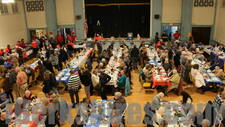June Lauzon Estate Gifts $3.5 Mil To Clark12:00AM / Wednesday, February 28, 2007
 | | A decanter from Sterling and Francine Clark Art Institute's Lauzon collection. [Photo courtesy of the Clark Art Institute] |
Williamstown - The Sterling and Francine Clark Art Institute has received a bequest of $3.5 million from the estate of June Lauzon.
The Lauzon bequest includes a monetary gift of $1 million and real estate valued at approximately $2.5 million, and will help ensure a prominent home for the Albert and June Lauzon Collection of Early American Blown Glass in a new gallery dedicated to American decorative arts planned as part of the renovation of the Clark's original museum building. Annabelle Selldorf was recently selected as the architect to oversee the renovation.
"June Lauzon was an amazing woman who was truly passionate about the Clark and its mission," said Clark director Michael Conforti. "Her commitment to the Clark, that began with the loan of works from her own collection and grew to the permanent donation of the collection, culminates with this generous bequest that will create a lasting legacy."
Albert And June Lauzon
Lauzon and her husband Albert were extraordinary supporters of the Clark and avid collectors of fine, early American glass. In their lifetimes they donated pieces from their collection and funded the purchase of additional objects thereby creating the Albert and June Lauzon Collection of Early American Blown Glass at the Clark. They spent summers touring New England and the Midwest searching for near perfect examples.
Beginning in 1975, the Lauzons lent a large portion of their impressive collection to the Clark, donating it in 1981.
Throughout her life June continued to add pieces to the Clark's collection that now totals 150, with pieces dating from the late 18th to mid-19th century including American free-blown, pattern-molded and mold-blown wares, as well as English and Continental export glass. In a 1988 Clark exhibition, selections from the Lauzon collection highlighted the development of the glass industry in America.
The collection is distinguished by numerous examples of free-blown, blown pattern-molded, and especially what has traditionally been called "blown-three-mold" glass. While much of the free-blown and blown pattern-molded glass retains the influence of form and decoration of imported European glass, American innovation led to the development of glass that was blown in multiple part, hinged molds ("blown-three-mold"), a technique that led to specifically American forms and design. The collection also contains significant examples of Bohemian and English glass of the type imported to America, inspiring and stimulating the developing American glass trade.
The bequest also includes proceeds that will result from the sale of the Lauzon's long-time Cape Cod home in Chatham, Mass.. It is situated on 2.5 acres of landscaped grounds sweeping down to Ryder's Cove in Pleasant Bay. The house has been magnificently preserved and maintains much of its original character including four fireplaces. The 1823 Captain Joshua Crowell House is steeped in local history and legend, and according to a note left by a descendant of the builder, Captain Joshua sent his ships to Maine for the lumber used in the house, and had it laid outside for a full year so that it would season properly.
The Clark is currently engaged in a building expansion and campus enhancement program that was first announced in 2003. The first phase of the Clark's master plan, Stone Hill Center designed by Pritzker Prize winning architect Tadao Ando, will include new galleries, a meeting and studio art classroom, a terrace, an outdoor café, and the Williamstown Art Conservation Center.
The building is under construction and scheduled to open in summer 2008. Phase 2 includes the renovation of the original museum building, the building housing the Clark library and administrative offices, and a new Exhibition, Visitor, and Conference Center also designed by Tadao Ando, scheduled to be completed in 2013.
The Clark
Set amidst 140 bucolic acres in the picturesque Berkshires, the Clark is one of the few major art museums in the United States that also serves as a leading international center for research and scholarship. In addition to its extraordinary collections, the Clark organizes groundbreaking special exhibitions that advance new scholarship and presents an array of public and educational programs. The Clark's research and academic programs include an international fellowship program and regular conferences, symposia, and colloquia. Its programs draw university and museum professionals from around the world. The Clark, together with Williams College, sponsors one of the nation's leading master's programs in art history and encompasses one of the most comprehensive art history libraries in the world.
The Clark is located at 225 South Street in Williamstown. The galleries are open Tuesday through Sunday from 10 am to 5 pm (daily in July and August). Admission is free November through May. Admission June 1 through October 31 is $12.50 for adults, free for children 18 and younger, members, and students with valid ID. For more information, call 413-458-2303 or visit www.clarkart.edu.
|



















